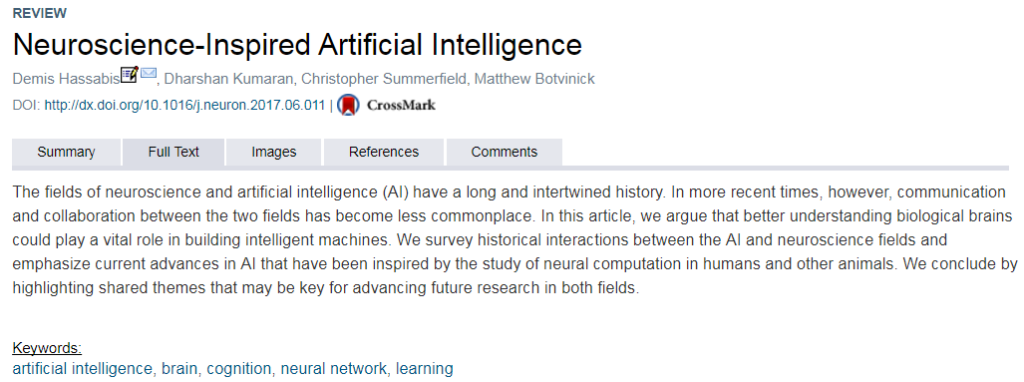This week, Neuron published a review titled Neuroscience-Inspired Artificial Intelligence, authored by Demis Hassabis (the cofounder of DeepMind and creator of AlphaGo) , Dharshan Kumaran (computational neuroscientist) , Christopher Summerfield (cognitive neuroscientist), and Matthew Botvinick (experimental psychologist). The authors called for a wide collaboration and communication between neuroscience community and computer science/engineering, illustrated how AI algorithms nowadays were inspired and validated by neuroscience, and envisioned a future where integrated AI and neuroscience research might yield insights into human cognition and smarter machines. When I was reading this review, I felt a deep excitement: I am so fortunate to witness the interaction of these two fields, not only as an audience, but also as a practitioner.
As a neuroscientist by training, I have studied odor perception and memory in fruit flies, prefrontal cortex and working memory in human, molecular mechanism of Parkinson’s Disease, and the biophysical properties of synapses at nanometer resolution in rats. It is always intriguing to me how 100 billion neurons in our head define where we came from, who we are, and what we plan to do. Neuroscientists have been investigating questions including: How do we perceive the world? How do we recognize pattern? How do we learn? How do we know what to remember and what to forget? How do we make decisions? How do we evaluate rewards and punishment? At a more fundamental level, how does a neuron or a group of neurons encode information? If the half life of most intracellular proteins is shorter than a few days, how can we maintain long term memory that lasts for decades?
Neuroscience textbooks have rudimentary answers to most questions listed above, but nothing is crystal clear. For example, although current mainstream neuroscience may tell you dopamine is in charge of the reward system, a quick literature search will tell you serotonin also plays a role. That’s why it never gets boring attending a neuroscience conference such as SfN.
In my PhD research, I also have the opportunity to combine physics with neuroscience, and build theoretical models to help explain experimental data. Physicists think quite differently from neuroscientists: physicists seem to have a SOLID love for modeling and simulation, while neuroscientists tend to have a MIND-BLOWING enthusiasm for experiment and raw data. It is a lot of fun to do both and blow a solid mind 😉
Now at Tapad, I am working with senior data scientists on machine learning. At first glance, it seems like a huge stretch from academia research to tech industry. I really value the intellectual challenges presented in academia and was not sure whether working in a company could bring me the same feeling of challenges and achievement. Honestly speaking, when I applied for Tapad, I knew very little about ad-tech, and the challenges and obstacles in the field. It was until the interview, when the interviewers (data scientists) explained to me their current projects and encouraged me to share my thoughts, I started to realize the job as a data scientist at Tapad was quite research focused, aiming at solving hard problems.
My second week at Tapad feels like doing research in graduate school. Before I started to write the first line of code, I spent most of this week reading peer-reviewed research articles, synthesizing ideas, and ruminating. With the guidance of my mentor, I wrote a to-do list of tasks ranked by priority and the estimated time for each task. The research part is quite familiar to me, and I really enjoy cross-referencing algorithms from different authors and time, and comparing their results. In my eyes, algorithms are like experimental protocols: understanding the mechanism is more crucial than the implementation.
How much would my academic experience in neuroscience and physics boost my research on machine learning at Tapad? I will come to this question at the end of the internship. I believe the answer is more than a “byte”.
